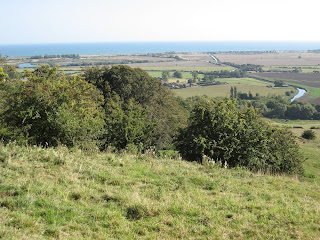From Canterbury we moved to Daleacres Caravan Site near Hythe. We wanted to be here for the Heritage weekend so we could see the sound mirrors at Denge. As a bonus the The Grand shaft was open in Dover on the Saturday. It is only open three times a year.
The shaft is an ingenious construction of brick measuring 26 feet (8 metres) in diameter and 140 feet (42 metres) in height. It was built between 1806 – 1809. It has three staircases of Purbeck limestone which wind clockwise one above the other down a central brick light and ventilation shaft lit by an occasional window. At the bottom the three staircases meet in the sloping corridor which leads to Snargate Street. There are 200 steps in all separated by several landings.
Here we see Sue on the steps leading to the top entrance of the shaft.

This is a view from the bottom looking up the centre of the staircase.

A forerunner of Radar, acoustic mirrors were built on the south and northeast coasts of England between about 1916 and the 1930s. The 'listening ears' were intended to provide early warning of incoming enemy aeroplanes and airships about to attack coastal towns. With the development of faster aircraft the sound mirrors became less useful, as an aircraft would be within sight by the time it had been located, and radar finally rendered the mirrors obsolete.
Here you can see the 30 foot mirror.

The mirrors did work, but the development of faster aircraft made them less useful, as an incoming aircraft would be within sight by the time it had been located. Increasing ambient noise made the mirrors harder to use successfully, and then radar rendered acoustic detection redundant.
This is the 200 foot mirror which when you are close to it looks huge.

All 141 people listening to the talk from our leader.




































